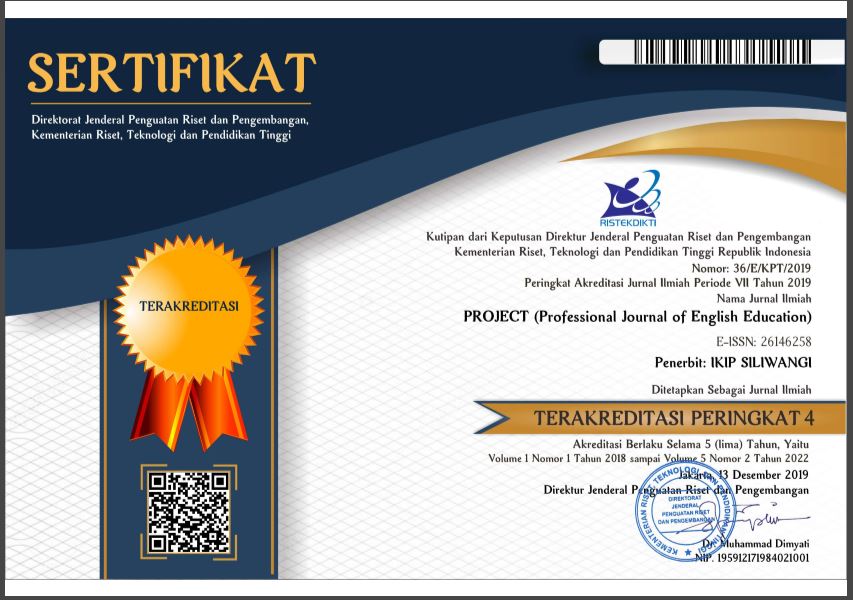AN ANALYSIS OF DEIXIS USED IN FACEBOOK AND INSTAGRAM POSTED BY EFL STUDENTS
Abstract
The aims of this study are to find out types of deixis used, the most dominant deixis and the interpretation of deixis used by EFL students. Descriptive research was used for this study. The participants of this research was 65 EFL students in English Language Department batch 2020 Univeristas Tanjungpura Pontianak. The data source was the English posts in Facebook and Instagram posted from January 2022 until December 2022. The research findings showed that 5 out of 5 types of deixis with in total 571 data used by EFL students in their Facebook and Instagram posts. The most dominant deixis used is person deixis with 363 data or 63,57%, place deixis with 97 data or 16,98%, and time deixis 65 data or 11,38%. The interpretation of person deixis as the dominant used by the EFL students to interpret the used of Instagram and Facebook to share their stories, from their point of view of how a person felt at the moment. The implication of this research helps EFL students to navigate the use of context, improving the ability to communicate affectively and understand the variations in both written and spoken English.
References
Dwipayani, N. M., Subagia, I. K., & Gede Suarjaya, A. A. (2020). Deixis found in movie script Sing. Jurnal Bahasa Dan Budaya, 4(1). https://doi.org/10.22225/kulturistik.4.1.1574
Gay, L.R. Mills, G.E. Airasian, P. . (2012). Educational research: Competencies and applications. Pearson.
George Yule. (1996). Pragmatics (H. G. Widdowson (ed.); 1st ed.). Oxford University Press.
Ginting, N. A., & Syahri, C. (2021). Deixis in Justin Bieber’s songs. Professional Journal of English Education, 4(1), 55. https://doi.org/10.22460/project.v4i1.p55-61 .
Kusumaningtyas, D. P. S., & Halimah. (2020). A comparative analysis pragmatics of social deixis in Chinese and Indonesian. Talenta Conference Series: Local Wisdom, Social, and Arts, 3(4), 26–30. https://doi.org/10.32734/lwsa.v3i4.1125
Lakhal, M. (2021). Social Media use and its effects on writing ability among Moroccan university EFL students. International Journal of English Literature and Social Sciences, 6(3), 132–143. https://doi.org/10.22161/ijels
Lestari, D. E., & German, E. (2021). Incorporating Instagram features in EFL learning environment. Metathesis: Journal of English Language, Literature, and Teaching, 5(2). https://doi.org/10.31002/metathesis.v5i2.4192
Levinson, S. . (1991). Pragmatics (3rd ed.). Cambridge University Press.
Mukhlif, M. I., & Challob, A. I. (2021). Enhancing vocabulary knowledge among secondary school EFL students by using facebook. Turkish Online Journal of Distance Education, 22(3). https://doi.org/10.17718/tojde.961852
Natalia, Y. Y., & Santoso, I. (2020). Person deixis and spatial deixis of king dangdut by Rhoma Irama songs. Professional Journal of English Education, 3(3). https://doi.org/10.22460/project.v3i3.p348-353
Pratiwi, S. (2018). Person deixis in English translation of summarized Shahih Al-Bukhari Hadith in the Book of As-Salat. Advances in Language and Literary Studies, 9(1). https://doi.org/10.7575/aiac.alls.v.9n.1p.40
Santoso, M. N. (2021). Utilizing a facebook closed group for efl e-learning environment: Students’ views. Studies in English Language and Education, 8(3). https://doi.org/10.24815/siele.v8i3.21233
Sitorus, E. (2019). A deixis analysis of song lyrics in Calum Scott “You are the reason.” International Journal of Science and Qualitative Analysis, 5(1), 24. https://doi.org/10.11648/j.ijsqa.20190501.14
Williams, N. (2020). Deixis and indexicals. The International Encyclopedia of Linguistic Anthropology, April, 1–9. https://doi.org/10.1002/9781118786093.iela0092
Downloads
Published
Issue
Section
License

This work is licensed under a Creative Commons Attribution-ShareAlike 4.0 International License.




